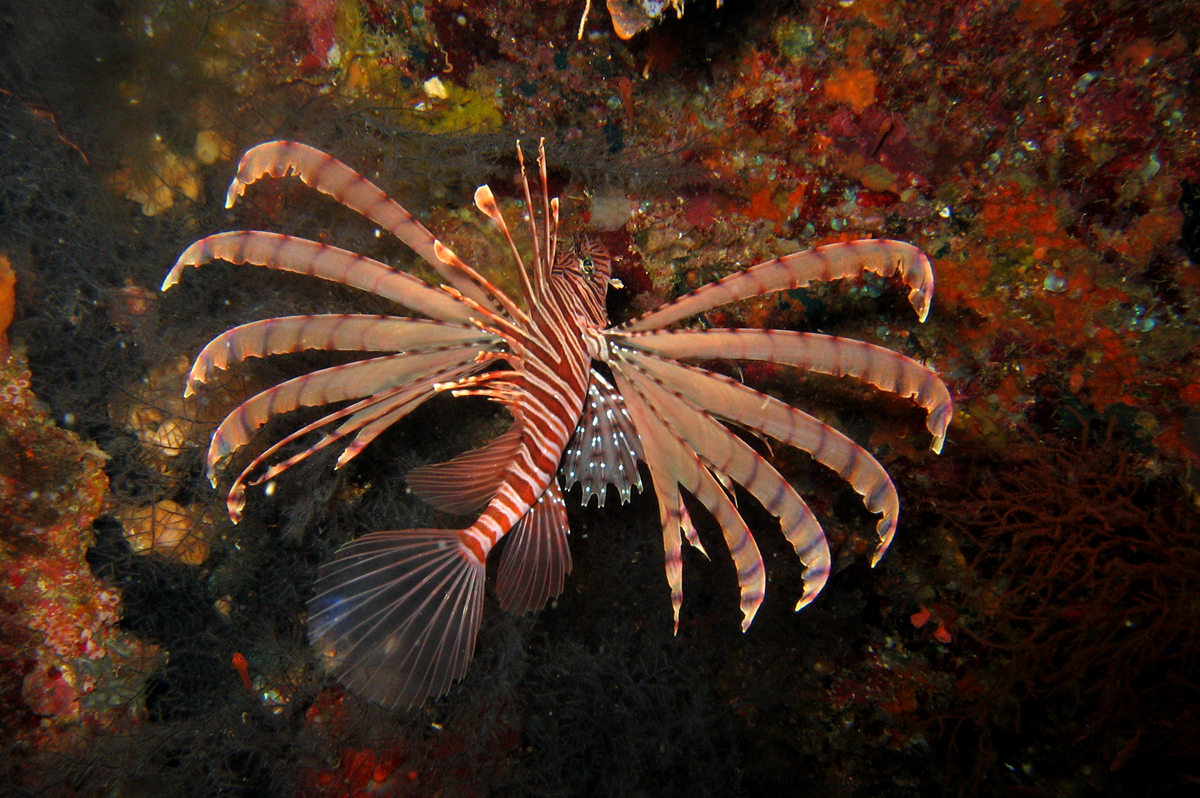Plaintail Lionfish, Pterois russelii Bennett 1831
Other Names: Largetail Turkeyfish, Plaintail Firefish, Plaintail Turkeyfish, Russell's Firefish, Russell's Lionfish, Spotless Butterfly-cod, Spotless Firefish

A Plaintail Lionfish, Pterois russelii, at Tingloy, Maricaban Island, Batangas, Philippines, August 2015. Source: Nicolas Bailly / FishBase. License: CC by Attribution-NonCommercial
Summary:
A lionfish without rows of small dark spots on the soft dorsal, anal and caudal fins,and relatively short dorsal-fin spines.
Cite this page as:
Bray, D.J. 2017, Pterois russelii in Fishes of Australia, accessed 26 Apr 2024, https://fishesofaustralia.net.au/home/species/3647
Plaintail Lionfish, Pterois russelii Bennett 1831
More Info
|
Distribution |
Exmouth Gulf, Western Australia, around the tropical north to the Great Barrier Reef, Queensland. Elsewhere the species is widespread and common throughout the Indo-west Pacific (absent from Papua New Guinea and the Solomon Islands). Inhabits muddy areas in well-protected shallow estuaries, bays and coastal waters, to quiet, deeper offshore reefs. |
|
Similar Species |
The Plaintail Lionfish is often misidentified as Pterois volitans, which has rows of small dark spots on the soft dorsal, anal and caudal fins. |
|
Species Citation |
Pterois russelii Bennett 1831, Proc. Comm. Sci. Corresp. Zool. Soc. Lond. 1: 128. Type locality: Coromandel coast, India, eastern Indian Ocean. |
|
Author |
Bray, D.J. 2017 |
|
Resources |
Plaintail Lionfish, Pterois russelii Bennett 1831
References
Allen, G.R. 1997. Marine Fishes of Tropical Australia and South-east Asia. Perth : Western Australian Museum 292 pp. 106 pls.
Allen, G.R. & Erdmann, M.V. 2008. Pterois andover, a new species of scorpionfish (Pisces: Scorpaenidae) from Indonesia and Papua New Guinea. Aqua, International Journal of Ichthyology 13(3-4): 127-138.
Allen, G.R. & Erdmann, M.V. 2012. Reef fishes of the East Indies. Perth : Tropical Reef Research 3 vols, 1260 pp.
Allen, G.R. & Swainston, R. 1988. The Marine Fishes of North-Western Australia. A field guide for anglers and divers. Perth, WA : Western Australian Museum vi 201 pp., 70 pls.
Bennett, E.T. 1831. Observations on a collection of fishes from the Mauritius, with characters of new genera and species. Proceedings of the Committee of Science and Correspondence of the Zoological Society of London 1: 59-61, 126-128.
Blaber, S.J.M., Brewer, D.T. & Harris, A.N. 1994. Distribution, biomass and community structure of demersal fishes of the Gulf of Carpentaria, Australia. Aust. J. Mar. Freshwat. Res. 45(3):375-396.
Gloerfelt-Tarp, T. & Kailola, P.J. 1984. Trawled Fishes of Southern Indonesia and Northwest Australia. Jakarta : Dir. Gen. Fish. (Indonesia), German Tech. Coop., Aust. Dev. Ass. Bur. 406 pp.
Kuiter, R.H. 1996. Guide to Sea Fishes of Australia. A comprehensive reference for divers and fishermen. Sydney, NSW, Australia : New Holland Publishers xvii, 434 pp.
Kuiter, R.H. & Tonozuka, T. 2001. Indonesian Reef Fishes. Part 1. Eels- Snappers, Muraenidae - Lutjanidae. Australia : Zoonetics pp. 1-302.
Motomura, H. & Matsuura, K. 2016. Pterois russelii. The IUCN Red List of Threatened Species 2016: e.T50903260A54145434. http://dx.doi.org/10.2305/IUCN.UK.2016-3.RLTS.T50903260A54145434.en. Downloaded on 07 April 2017.
Poss, S.G. 1999. Families Scorpaenidae, Caracanthidae, Aploactinidae. pp. 2291-2358 in Carpenter, K.E. & Niem, T.H. (eds) The Living Marine Resources of the Western Central Pacific. FAO Species Identification Guide for Fisheries Purposes. Rome : FAO Vol. 4 pp. 2069-2790.
Randall, J.E., Allen, G.R. & Steene, R. 1997. Fishes of the Great Barrier Reef and Coral Sea. Bathurst : Crawford House Press 557 pp. figs.
Russell, B.C. & Houston, W. 1989. Offshore fishes of the Arafura Sea. The Beagle, Records of the Museums and Art Galleries of the Northern Territory 6(1): 69-84.
Sainsbury, K.J., Kailola, P.J. & Leyland, G.G. 1984. Continental Shelf Fishes of Northern and North-Western Australia. Canberra : Fisheries Information Service 375 pp. figs & pls.









